Strategic Innovation Management: Vodafone's Plan for Future Growth
VerifiedAdded on 2024/06/28
|17
|4050
|403
Report
AI Summary
This report provides an analysis of innovation management at Vodafone, a telecommunications organization, focusing on strategies for competitiveness and future growth. It examines industry trends, including the increasing use of VR, AR, voice recognition, IoT, and AI, to identify opportunities for Vodafone in the digital era. The report develops an innovation roadmap for Vodafone by assessing the company's innovation capabilities and identifying potential blockages. It emphasizes the importance of organizational knowledge in fostering innovation and recommends the adoption of the Change Acceleration Process (CAP) to facilitate knowledge transfer and cross-functional cooperation. The report highlights Vodafone's existing innovation capabilities, such as its advanced research team and brand awareness, while also addressing potential challenges like competition and decreasing brand value. Ultimately, the report aims to guide Vodafone in developing new innovative products and services to achieve sustained growth and success in the market.
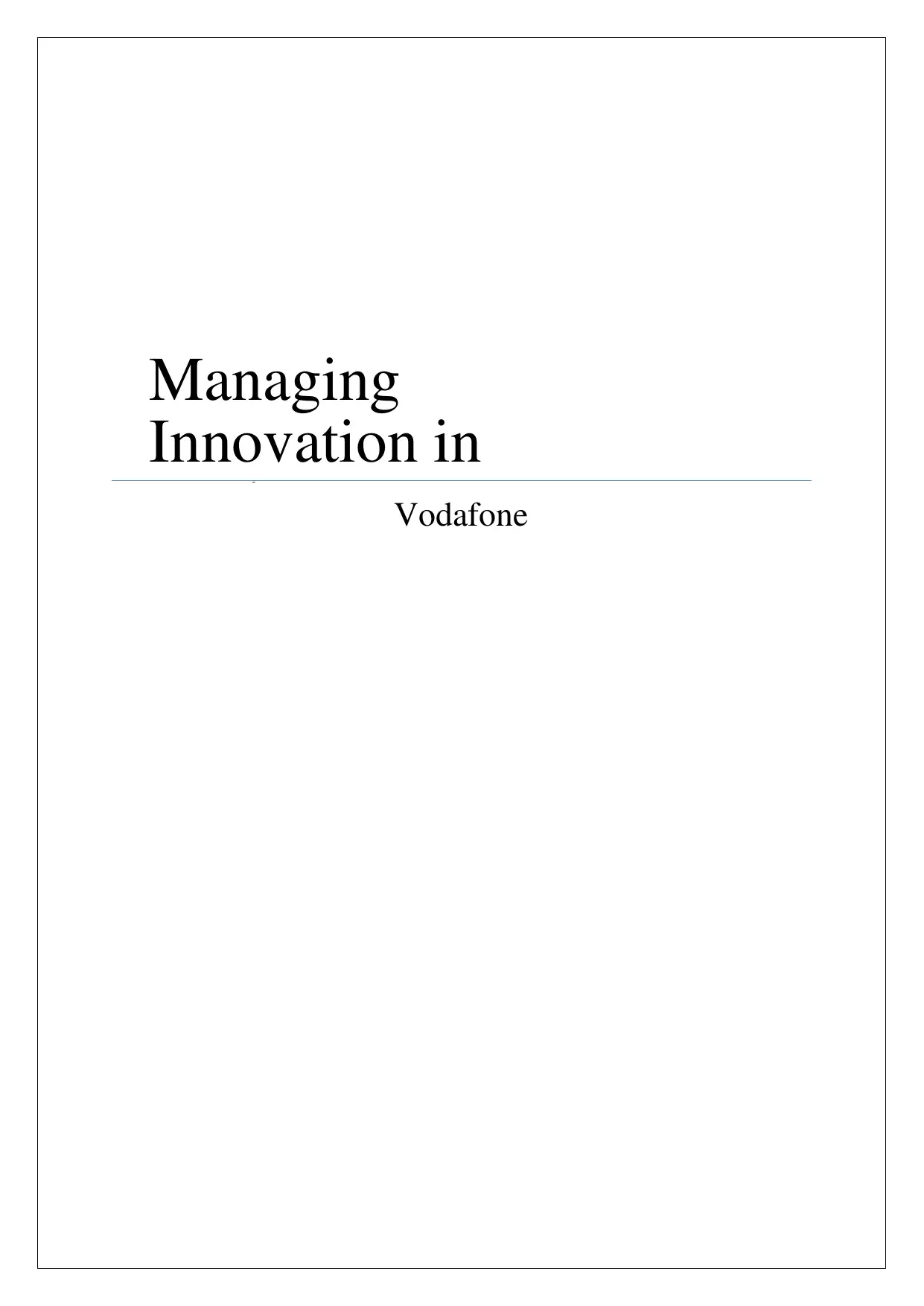
Paraphrase This Document
Need a fresh take? Get an instant paraphrase of this document with our AI Paraphraser
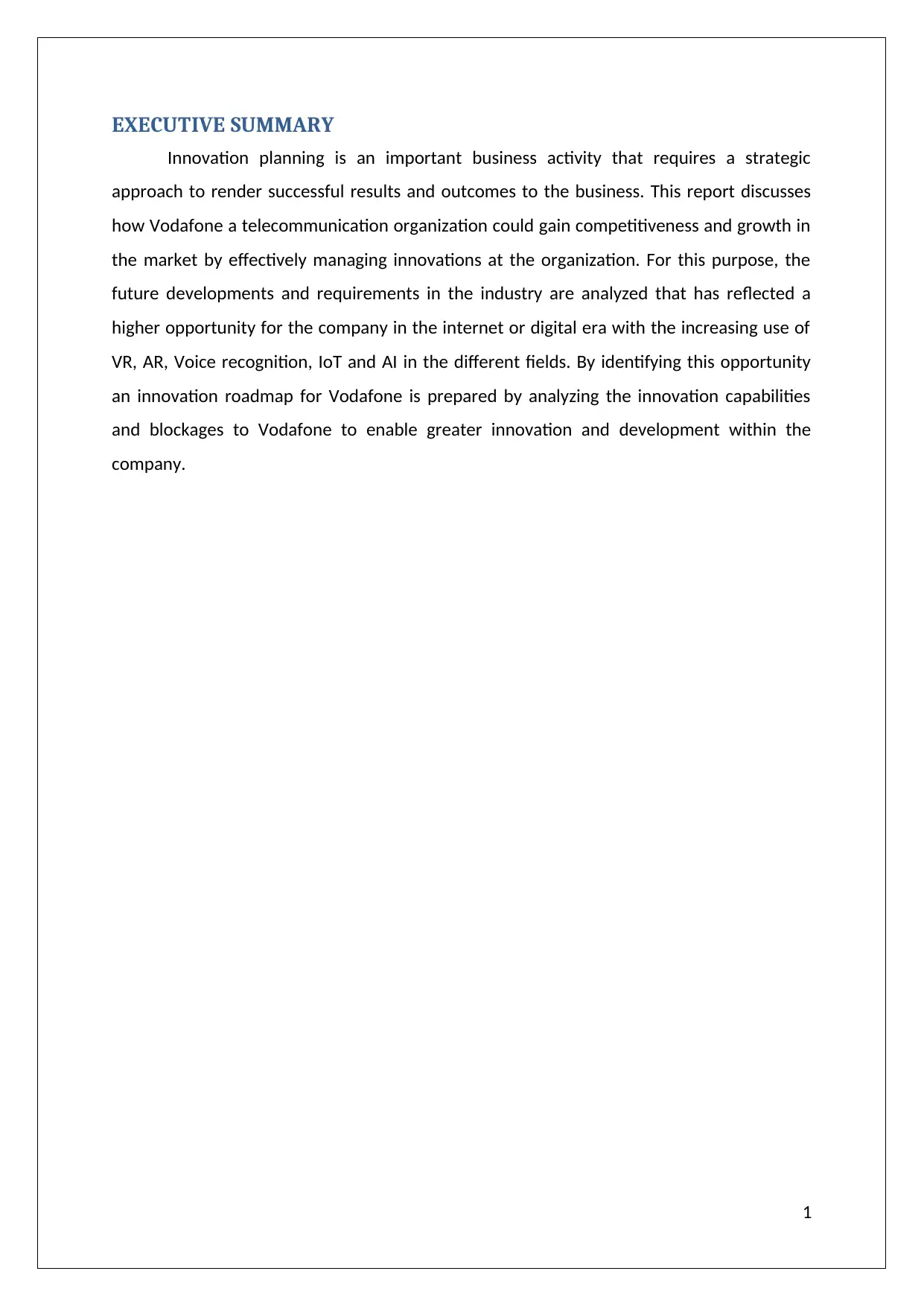
EXECUTIVE SUMMARY
Innovation planning is an important business activity that requires a strategic
approach to render successful results and outcomes to the business. This report discusses
how Vodafone a telecommunication organization could gain competitiveness and growth in
the market by effectively managing innovations at the organization. For this purpose, the
future developments and requirements in the industry are analyzed that has reflected a
higher opportunity for the company in the internet or digital era with the increasing use of
VR, AR, Voice recognition, IoT and AI in the different fields. By identifying this opportunity
an innovation roadmap for Vodafone is prepared by analyzing the innovation capabilities
and blockages to Vodafone to enable greater innovation and development within the
company.
1
Innovation planning is an important business activity that requires a strategic
approach to render successful results and outcomes to the business. This report discusses
how Vodafone a telecommunication organization could gain competitiveness and growth in
the market by effectively managing innovations at the organization. For this purpose, the
future developments and requirements in the industry are analyzed that has reflected a
higher opportunity for the company in the internet or digital era with the increasing use of
VR, AR, Voice recognition, IoT and AI in the different fields. By identifying this opportunity
an innovation roadmap for Vodafone is prepared by analyzing the innovation capabilities
and blockages to Vodafone to enable greater innovation and development within the
company.
1
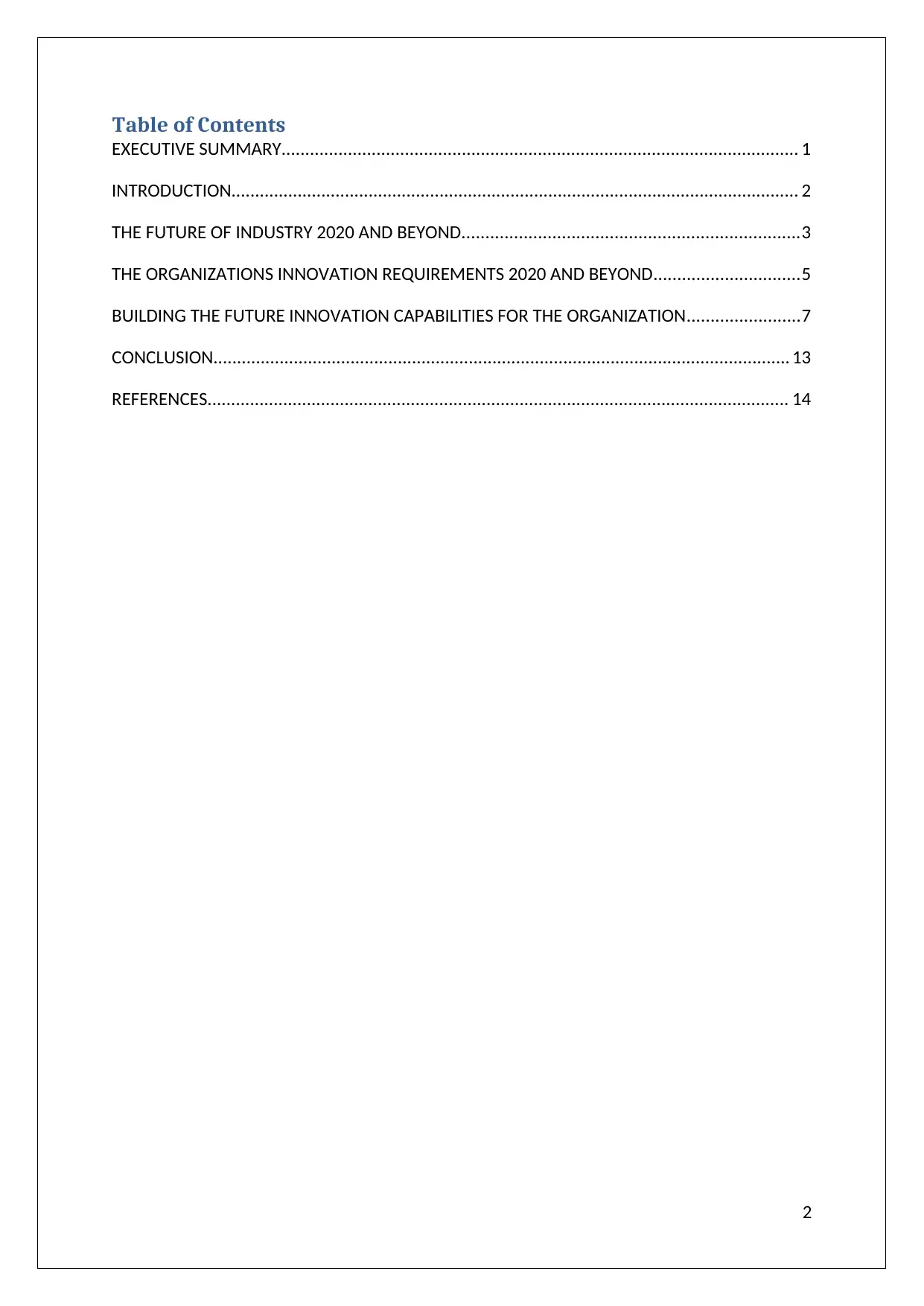
Table of Contents
EXECUTIVE SUMMARY............................................................................................................. 1
INTRODUCTION........................................................................................................................ 2
THE FUTURE OF INDUSTRY 2020 AND BEYOND.......................................................................3
THE ORGANIZATIONS INNOVATION REQUIREMENTS 2020 AND BEYOND...............................5
BUILDING THE FUTURE INNOVATION CAPABILITIES FOR THE ORGANIZATION........................7
CONCLUSION.......................................................................................................................... 13
REFERENCES........................................................................................................................... 14
2
EXECUTIVE SUMMARY............................................................................................................. 1
INTRODUCTION........................................................................................................................ 2
THE FUTURE OF INDUSTRY 2020 AND BEYOND.......................................................................3
THE ORGANIZATIONS INNOVATION REQUIREMENTS 2020 AND BEYOND...............................5
BUILDING THE FUTURE INNOVATION CAPABILITIES FOR THE ORGANIZATION........................7
CONCLUSION.......................................................................................................................... 13
REFERENCES........................................................................................................................... 14
2
⊘ This is a preview!⊘
Do you want full access?
Subscribe today to unlock all pages.

Trusted by 1+ million students worldwide
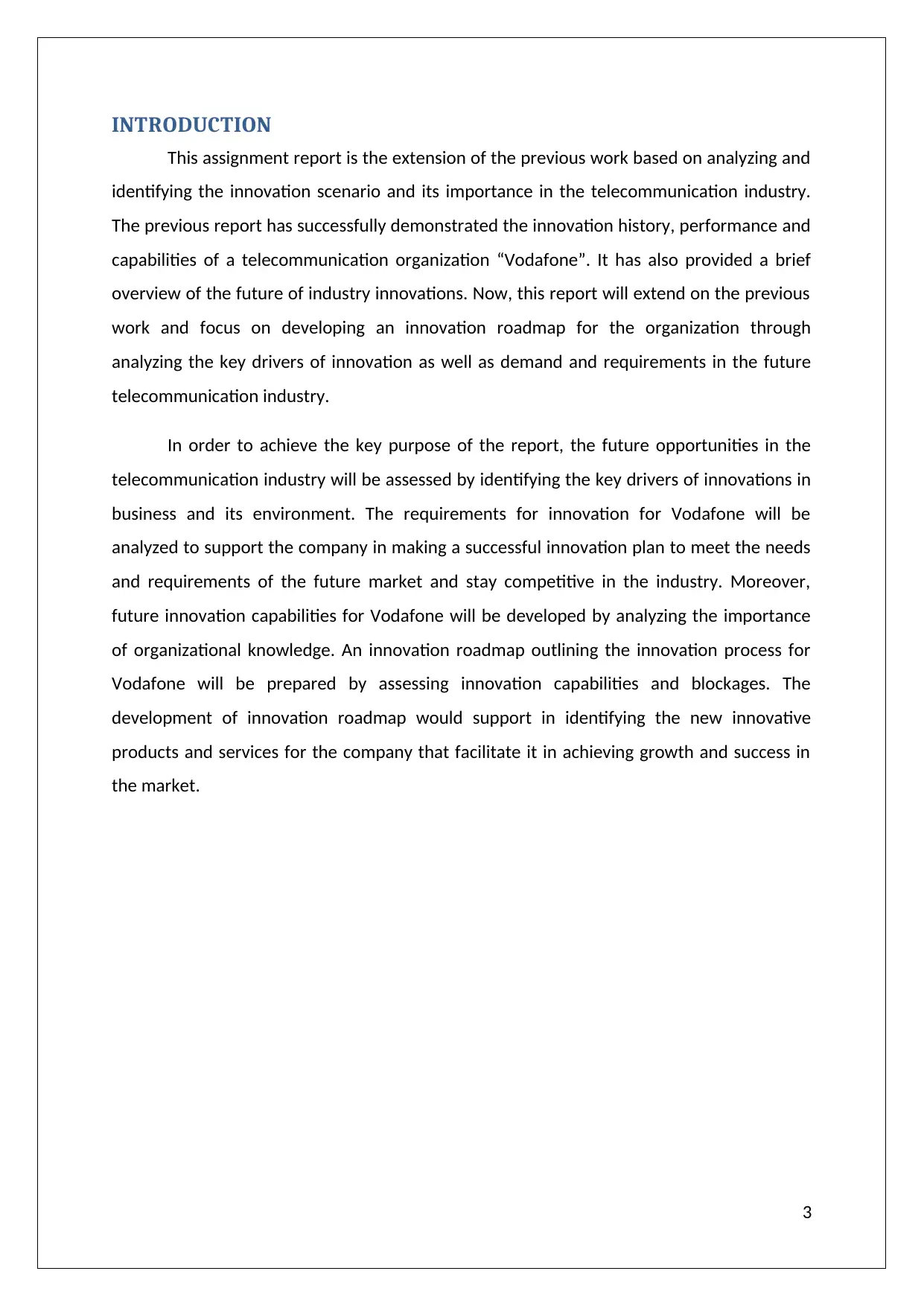
INTRODUCTION
This assignment report is the extension of the previous work based on analyzing and
identifying the innovation scenario and its importance in the telecommunication industry.
The previous report has successfully demonstrated the innovation history, performance and
capabilities of a telecommunication organization “Vodafone”. It has also provided a brief
overview of the future of industry innovations. Now, this report will extend on the previous
work and focus on developing an innovation roadmap for the organization through
analyzing the key drivers of innovation as well as demand and requirements in the future
telecommunication industry.
In order to achieve the key purpose of the report, the future opportunities in the
telecommunication industry will be assessed by identifying the key drivers of innovations in
business and its environment. The requirements for innovation for Vodafone will be
analyzed to support the company in making a successful innovation plan to meet the needs
and requirements of the future market and stay competitive in the industry. Moreover,
future innovation capabilities for Vodafone will be developed by analyzing the importance
of organizational knowledge. An innovation roadmap outlining the innovation process for
Vodafone will be prepared by assessing innovation capabilities and blockages. The
development of innovation roadmap would support in identifying the new innovative
products and services for the company that facilitate it in achieving growth and success in
the market.
3
This assignment report is the extension of the previous work based on analyzing and
identifying the innovation scenario and its importance in the telecommunication industry.
The previous report has successfully demonstrated the innovation history, performance and
capabilities of a telecommunication organization “Vodafone”. It has also provided a brief
overview of the future of industry innovations. Now, this report will extend on the previous
work and focus on developing an innovation roadmap for the organization through
analyzing the key drivers of innovation as well as demand and requirements in the future
telecommunication industry.
In order to achieve the key purpose of the report, the future opportunities in the
telecommunication industry will be assessed by identifying the key drivers of innovations in
business and its environment. The requirements for innovation for Vodafone will be
analyzed to support the company in making a successful innovation plan to meet the needs
and requirements of the future market and stay competitive in the industry. Moreover,
future innovation capabilities for Vodafone will be developed by analyzing the importance
of organizational knowledge. An innovation roadmap outlining the innovation process for
Vodafone will be prepared by assessing innovation capabilities and blockages. The
development of innovation roadmap would support in identifying the new innovative
products and services for the company that facilitate it in achieving growth and success in
the market.
3
Paraphrase This Document
Need a fresh take? Get an instant paraphrase of this document with our AI Paraphraser
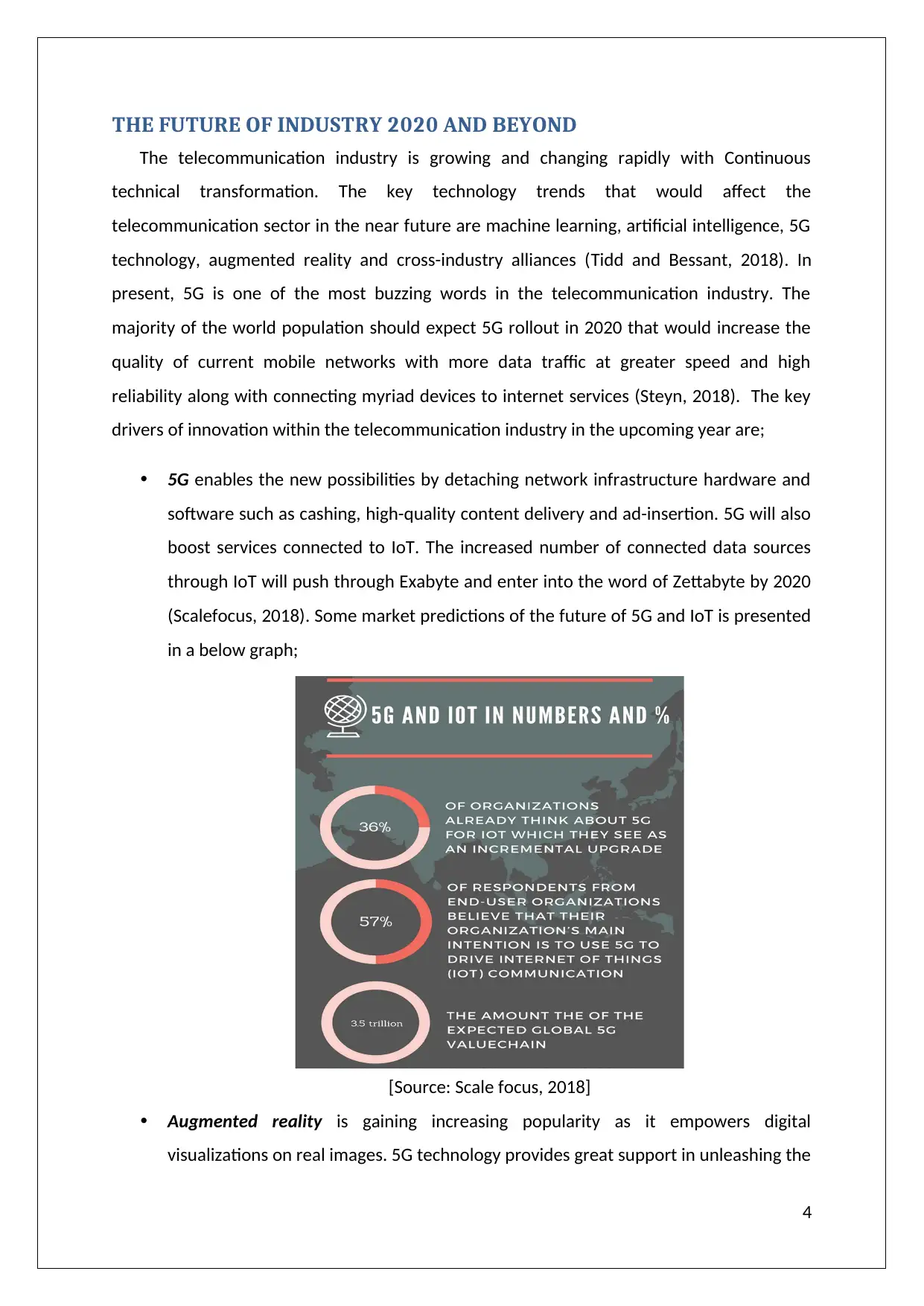
THE FUTURE OF INDUSTRY 2020 AND BEYOND
The telecommunication industry is growing and changing rapidly with Continuous
technical transformation. The key technology trends that would affect the
telecommunication sector in the near future are machine learning, artificial intelligence, 5G
technology, augmented reality and cross-industry alliances (Tidd and Bessant, 2018). In
present, 5G is one of the most buzzing words in the telecommunication industry. The
majority of the world population should expect 5G rollout in 2020 that would increase the
quality of current mobile networks with more data traffic at greater speed and high
reliability along with connecting myriad devices to internet services (Steyn, 2018). The key
drivers of innovation within the telecommunication industry in the upcoming year are;
5G enables the new possibilities by detaching network infrastructure hardware and
software such as cashing, high-quality content delivery and ad-insertion. 5G will also
boost services connected to IoT. The increased number of connected data sources
through IoT will push through Exabyte and enter into the word of Zettabyte by 2020
(Scalefocus, 2018). Some market predictions of the future of 5G and IoT is presented
in a below graph;
[Source: Scale focus, 2018]
Augmented reality is gaining increasing popularity as it empowers digital
visualizations on real images. 5G technology provides great support in unleashing the
4
The telecommunication industry is growing and changing rapidly with Continuous
technical transformation. The key technology trends that would affect the
telecommunication sector in the near future are machine learning, artificial intelligence, 5G
technology, augmented reality and cross-industry alliances (Tidd and Bessant, 2018). In
present, 5G is one of the most buzzing words in the telecommunication industry. The
majority of the world population should expect 5G rollout in 2020 that would increase the
quality of current mobile networks with more data traffic at greater speed and high
reliability along with connecting myriad devices to internet services (Steyn, 2018). The key
drivers of innovation within the telecommunication industry in the upcoming year are;
5G enables the new possibilities by detaching network infrastructure hardware and
software such as cashing, high-quality content delivery and ad-insertion. 5G will also
boost services connected to IoT. The increased number of connected data sources
through IoT will push through Exabyte and enter into the word of Zettabyte by 2020
(Scalefocus, 2018). Some market predictions of the future of 5G and IoT is presented
in a below graph;
[Source: Scale focus, 2018]
Augmented reality is gaining increasing popularity as it empowers digital
visualizations on real images. 5G technology provides great support in unleashing the
4
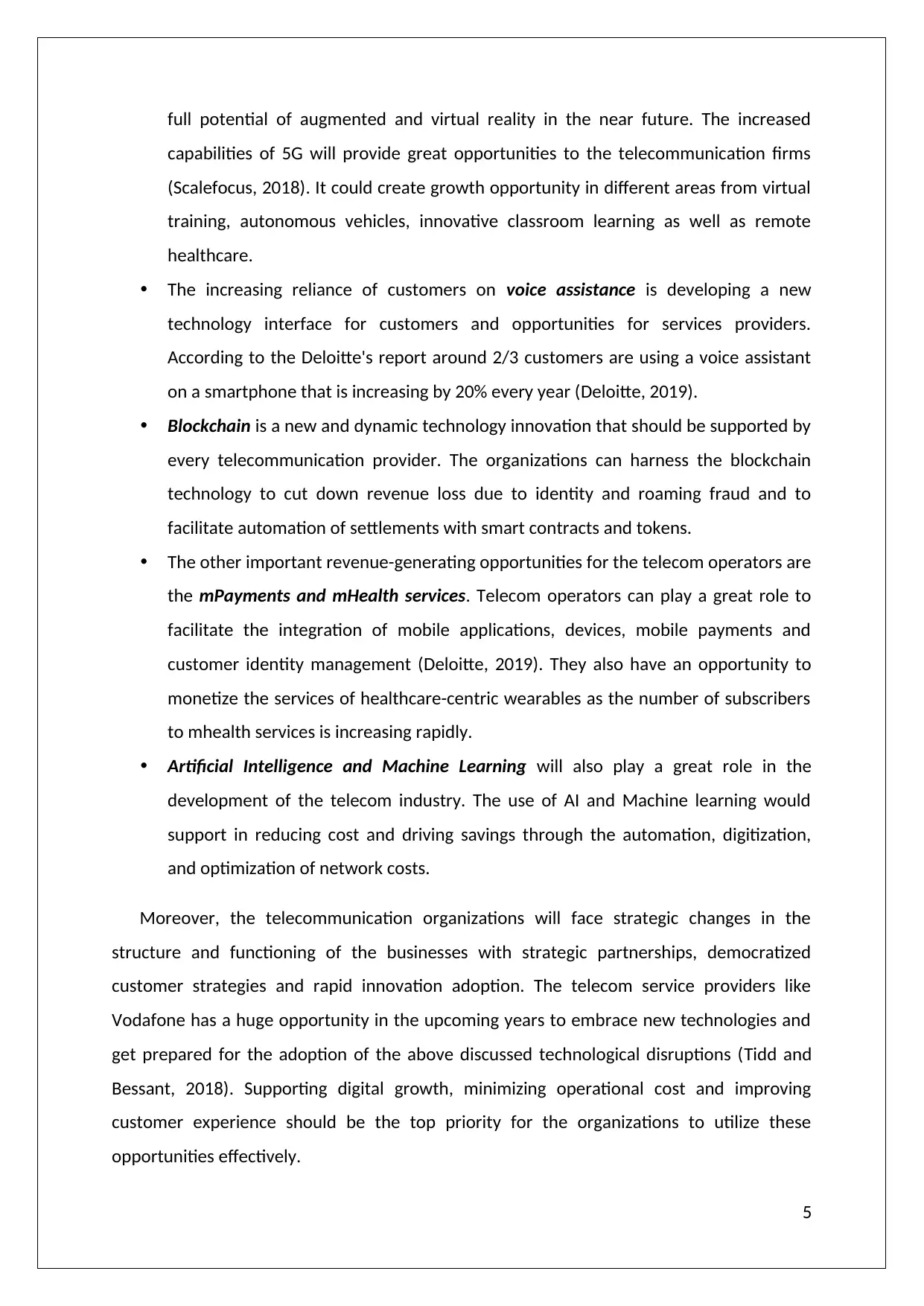
full potential of augmented and virtual reality in the near future. The increased
capabilities of 5G will provide great opportunities to the telecommunication firms
(Scalefocus, 2018). It could create growth opportunity in different areas from virtual
training, autonomous vehicles, innovative classroom learning as well as remote
healthcare.
The increasing reliance of customers on voice assistance is developing a new
technology interface for customers and opportunities for services providers.
According to the Deloitte's report around 2/3 customers are using a voice assistant
on a smartphone that is increasing by 20% every year (Deloitte, 2019).
Blockchain is a new and dynamic technology innovation that should be supported by
every telecommunication provider. The organizations can harness the blockchain
technology to cut down revenue loss due to identity and roaming fraud and to
facilitate automation of settlements with smart contracts and tokens.
The other important revenue-generating opportunities for the telecom operators are
the mPayments and mHealth services. Telecom operators can play a great role to
facilitate the integration of mobile applications, devices, mobile payments and
customer identity management (Deloitte, 2019). They also have an opportunity to
monetize the services of healthcare-centric wearables as the number of subscribers
to mhealth services is increasing rapidly.
Artificial Intelligence and Machine Learning will also play a great role in the
development of the telecom industry. The use of AI and Machine learning would
support in reducing cost and driving savings through the automation, digitization,
and optimization of network costs.
Moreover, the telecommunication organizations will face strategic changes in the
structure and functioning of the businesses with strategic partnerships, democratized
customer strategies and rapid innovation adoption. The telecom service providers like
Vodafone has a huge opportunity in the upcoming years to embrace new technologies and
get prepared for the adoption of the above discussed technological disruptions (Tidd and
Bessant, 2018). Supporting digital growth, minimizing operational cost and improving
customer experience should be the top priority for the organizations to utilize these
opportunities effectively.
5
capabilities of 5G will provide great opportunities to the telecommunication firms
(Scalefocus, 2018). It could create growth opportunity in different areas from virtual
training, autonomous vehicles, innovative classroom learning as well as remote
healthcare.
The increasing reliance of customers on voice assistance is developing a new
technology interface for customers and opportunities for services providers.
According to the Deloitte's report around 2/3 customers are using a voice assistant
on a smartphone that is increasing by 20% every year (Deloitte, 2019).
Blockchain is a new and dynamic technology innovation that should be supported by
every telecommunication provider. The organizations can harness the blockchain
technology to cut down revenue loss due to identity and roaming fraud and to
facilitate automation of settlements with smart contracts and tokens.
The other important revenue-generating opportunities for the telecom operators are
the mPayments and mHealth services. Telecom operators can play a great role to
facilitate the integration of mobile applications, devices, mobile payments and
customer identity management (Deloitte, 2019). They also have an opportunity to
monetize the services of healthcare-centric wearables as the number of subscribers
to mhealth services is increasing rapidly.
Artificial Intelligence and Machine Learning will also play a great role in the
development of the telecom industry. The use of AI and Machine learning would
support in reducing cost and driving savings through the automation, digitization,
and optimization of network costs.
Moreover, the telecommunication organizations will face strategic changes in the
structure and functioning of the businesses with strategic partnerships, democratized
customer strategies and rapid innovation adoption. The telecom service providers like
Vodafone has a huge opportunity in the upcoming years to embrace new technologies and
get prepared for the adoption of the above discussed technological disruptions (Tidd and
Bessant, 2018). Supporting digital growth, minimizing operational cost and improving
customer experience should be the top priority for the organizations to utilize these
opportunities effectively.
5
⊘ This is a preview!⊘
Do you want full access?
Subscribe today to unlock all pages.

Trusted by 1+ million students worldwide
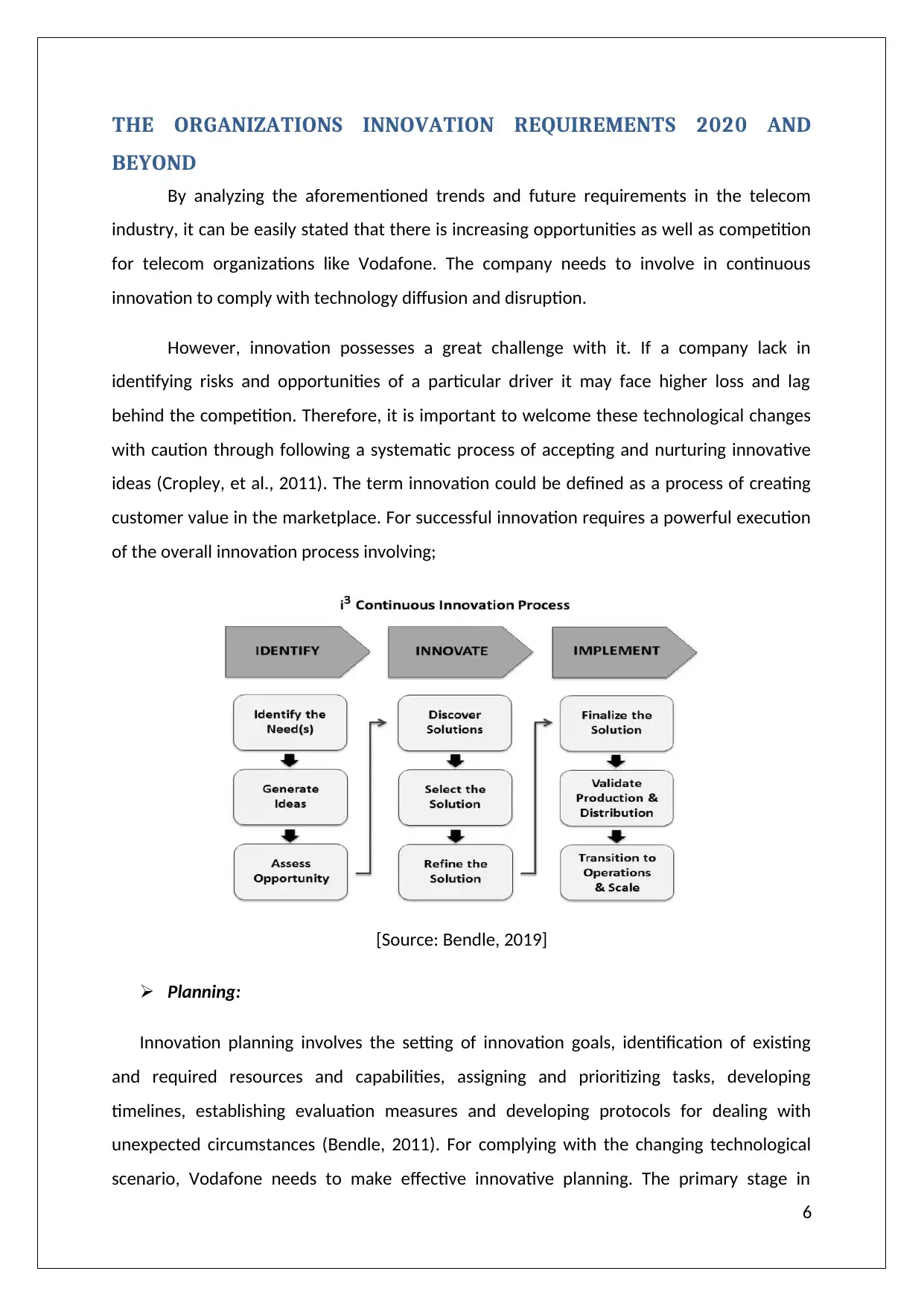
THE ORGANIZATIONS INNOVATION REQUIREMENTS 2020 AND
BEYOND
By analyzing the aforementioned trends and future requirements in the telecom
industry, it can be easily stated that there is increasing opportunities as well as competition
for telecom organizations like Vodafone. The company needs to involve in continuous
innovation to comply with technology diffusion and disruption.
However, innovation possesses a great challenge with it. If a company lack in
identifying risks and opportunities of a particular driver it may face higher loss and lag
behind the competition. Therefore, it is important to welcome these technological changes
with caution through following a systematic process of accepting and nurturing innovative
ideas (Cropley, et al., 2011). The term innovation could be defined as a process of creating
customer value in the marketplace. For successful innovation requires a powerful execution
of the overall innovation process involving;
[Source: Bendle, 2019]
Planning:
Innovation planning involves the setting of innovation goals, identification of existing
and required resources and capabilities, assigning and prioritizing tasks, developing
timelines, establishing evaluation measures and developing protocols for dealing with
unexpected circumstances (Bendle, 2011). For complying with the changing technological
scenario, Vodafone needs to make effective innovative planning. The primary stage in
6
BEYOND
By analyzing the aforementioned trends and future requirements in the telecom
industry, it can be easily stated that there is increasing opportunities as well as competition
for telecom organizations like Vodafone. The company needs to involve in continuous
innovation to comply with technology diffusion and disruption.
However, innovation possesses a great challenge with it. If a company lack in
identifying risks and opportunities of a particular driver it may face higher loss and lag
behind the competition. Therefore, it is important to welcome these technological changes
with caution through following a systematic process of accepting and nurturing innovative
ideas (Cropley, et al., 2011). The term innovation could be defined as a process of creating
customer value in the marketplace. For successful innovation requires a powerful execution
of the overall innovation process involving;
[Source: Bendle, 2019]
Planning:
Innovation planning involves the setting of innovation goals, identification of existing
and required resources and capabilities, assigning and prioritizing tasks, developing
timelines, establishing evaluation measures and developing protocols for dealing with
unexpected circumstances (Bendle, 2011). For complying with the changing technological
scenario, Vodafone needs to make effective innovative planning. The primary stage in
6
Paraphrase This Document
Need a fresh take? Get an instant paraphrase of this document with our AI Paraphraser
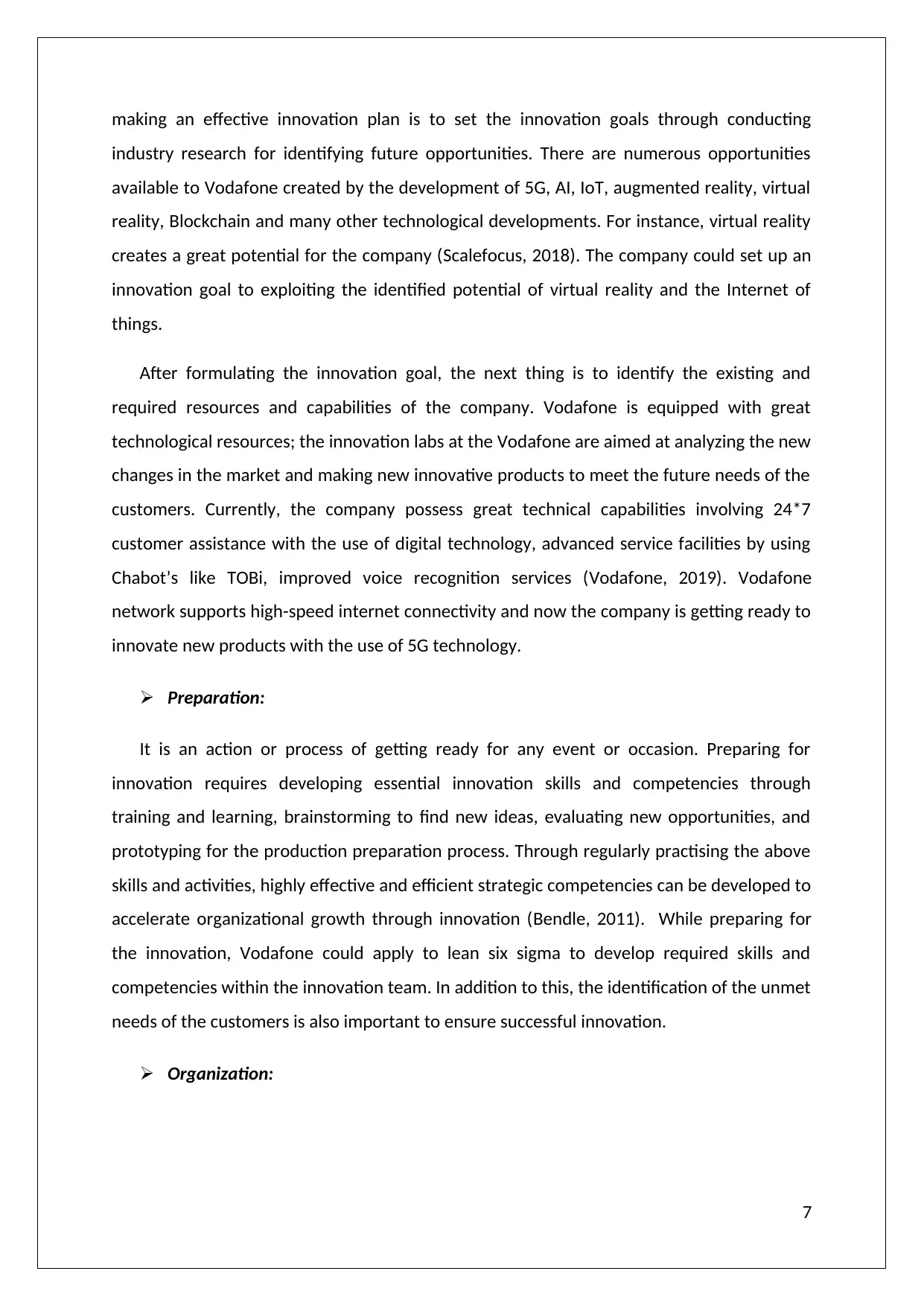
making an effective innovation plan is to set the innovation goals through conducting
industry research for identifying future opportunities. There are numerous opportunities
available to Vodafone created by the development of 5G, AI, IoT, augmented reality, virtual
reality, Blockchain and many other technological developments. For instance, virtual reality
creates a great potential for the company (Scalefocus, 2018). The company could set up an
innovation goal to exploiting the identified potential of virtual reality and the Internet of
things.
After formulating the innovation goal, the next thing is to identify the existing and
required resources and capabilities of the company. Vodafone is equipped with great
technological resources; the innovation labs at the Vodafone are aimed at analyzing the new
changes in the market and making new innovative products to meet the future needs of the
customers. Currently, the company possess great technical capabilities involving 24*7
customer assistance with the use of digital technology, advanced service facilities by using
Chabot’s like TOBi, improved voice recognition services (Vodafone, 2019). Vodafone
network supports high-speed internet connectivity and now the company is getting ready to
innovate new products with the use of 5G technology.
Preparation:
It is an action or process of getting ready for any event or occasion. Preparing for
innovation requires developing essential innovation skills and competencies through
training and learning, brainstorming to find new ideas, evaluating new opportunities, and
prototyping for the production preparation process. Through regularly practising the above
skills and activities, highly effective and efficient strategic competencies can be developed to
accelerate organizational growth through innovation (Bendle, 2011). While preparing for
the innovation, Vodafone could apply to lean six sigma to develop required skills and
competencies within the innovation team. In addition to this, the identification of the unmet
needs of the customers is also important to ensure successful innovation.
Organization:
7
industry research for identifying future opportunities. There are numerous opportunities
available to Vodafone created by the development of 5G, AI, IoT, augmented reality, virtual
reality, Blockchain and many other technological developments. For instance, virtual reality
creates a great potential for the company (Scalefocus, 2018). The company could set up an
innovation goal to exploiting the identified potential of virtual reality and the Internet of
things.
After formulating the innovation goal, the next thing is to identify the existing and
required resources and capabilities of the company. Vodafone is equipped with great
technological resources; the innovation labs at the Vodafone are aimed at analyzing the new
changes in the market and making new innovative products to meet the future needs of the
customers. Currently, the company possess great technical capabilities involving 24*7
customer assistance with the use of digital technology, advanced service facilities by using
Chabot’s like TOBi, improved voice recognition services (Vodafone, 2019). Vodafone
network supports high-speed internet connectivity and now the company is getting ready to
innovate new products with the use of 5G technology.
Preparation:
It is an action or process of getting ready for any event or occasion. Preparing for
innovation requires developing essential innovation skills and competencies through
training and learning, brainstorming to find new ideas, evaluating new opportunities, and
prototyping for the production preparation process. Through regularly practising the above
skills and activities, highly effective and efficient strategic competencies can be developed to
accelerate organizational growth through innovation (Bendle, 2011). While preparing for
the innovation, Vodafone could apply to lean six sigma to develop required skills and
competencies within the innovation team. In addition to this, the identification of the unmet
needs of the customers is also important to ensure successful innovation.
Organization:
7
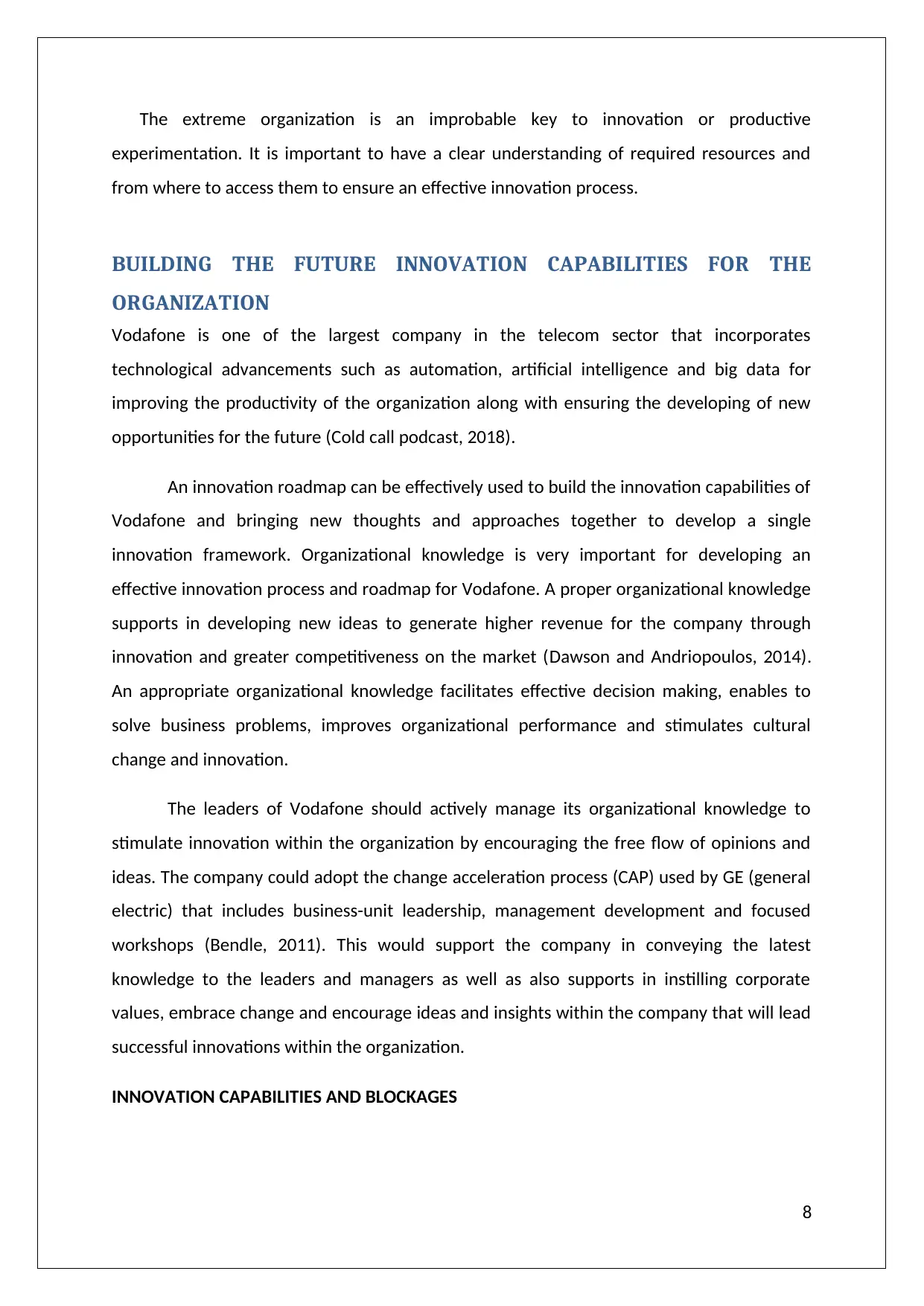
The extreme organization is an improbable key to innovation or productive
experimentation. It is important to have a clear understanding of required resources and
from where to access them to ensure an effective innovation process.
BUILDING THE FUTURE INNOVATION CAPABILITIES FOR THE
ORGANIZATION
Vodafone is one of the largest company in the telecom sector that incorporates
technological advancements such as automation, artificial intelligence and big data for
improving the productivity of the organization along with ensuring the developing of new
opportunities for the future (Cold call podcast, 2018).
An innovation roadmap can be effectively used to build the innovation capabilities of
Vodafone and bringing new thoughts and approaches together to develop a single
innovation framework. Organizational knowledge is very important for developing an
effective innovation process and roadmap for Vodafone. A proper organizational knowledge
supports in developing new ideas to generate higher revenue for the company through
innovation and greater competitiveness on the market (Dawson and Andriopoulos, 2014).
An appropriate organizational knowledge facilitates effective decision making, enables to
solve business problems, improves organizational performance and stimulates cultural
change and innovation.
The leaders of Vodafone should actively manage its organizational knowledge to
stimulate innovation within the organization by encouraging the free flow of opinions and
ideas. The company could adopt the change acceleration process (CAP) used by GE (general
electric) that includes business-unit leadership, management development and focused
workshops (Bendle, 2011). This would support the company in conveying the latest
knowledge to the leaders and managers as well as also supports in instilling corporate
values, embrace change and encourage ideas and insights within the company that will lead
successful innovations within the organization.
INNOVATION CAPABILITIES AND BLOCKAGES
8
experimentation. It is important to have a clear understanding of required resources and
from where to access them to ensure an effective innovation process.
BUILDING THE FUTURE INNOVATION CAPABILITIES FOR THE
ORGANIZATION
Vodafone is one of the largest company in the telecom sector that incorporates
technological advancements such as automation, artificial intelligence and big data for
improving the productivity of the organization along with ensuring the developing of new
opportunities for the future (Cold call podcast, 2018).
An innovation roadmap can be effectively used to build the innovation capabilities of
Vodafone and bringing new thoughts and approaches together to develop a single
innovation framework. Organizational knowledge is very important for developing an
effective innovation process and roadmap for Vodafone. A proper organizational knowledge
supports in developing new ideas to generate higher revenue for the company through
innovation and greater competitiveness on the market (Dawson and Andriopoulos, 2014).
An appropriate organizational knowledge facilitates effective decision making, enables to
solve business problems, improves organizational performance and stimulates cultural
change and innovation.
The leaders of Vodafone should actively manage its organizational knowledge to
stimulate innovation within the organization by encouraging the free flow of opinions and
ideas. The company could adopt the change acceleration process (CAP) used by GE (general
electric) that includes business-unit leadership, management development and focused
workshops (Bendle, 2011). This would support the company in conveying the latest
knowledge to the leaders and managers as well as also supports in instilling corporate
values, embrace change and encourage ideas and insights within the company that will lead
successful innovations within the organization.
INNOVATION CAPABILITIES AND BLOCKAGES
8
⊘ This is a preview!⊘
Do you want full access?
Subscribe today to unlock all pages.

Trusted by 1+ million students worldwide
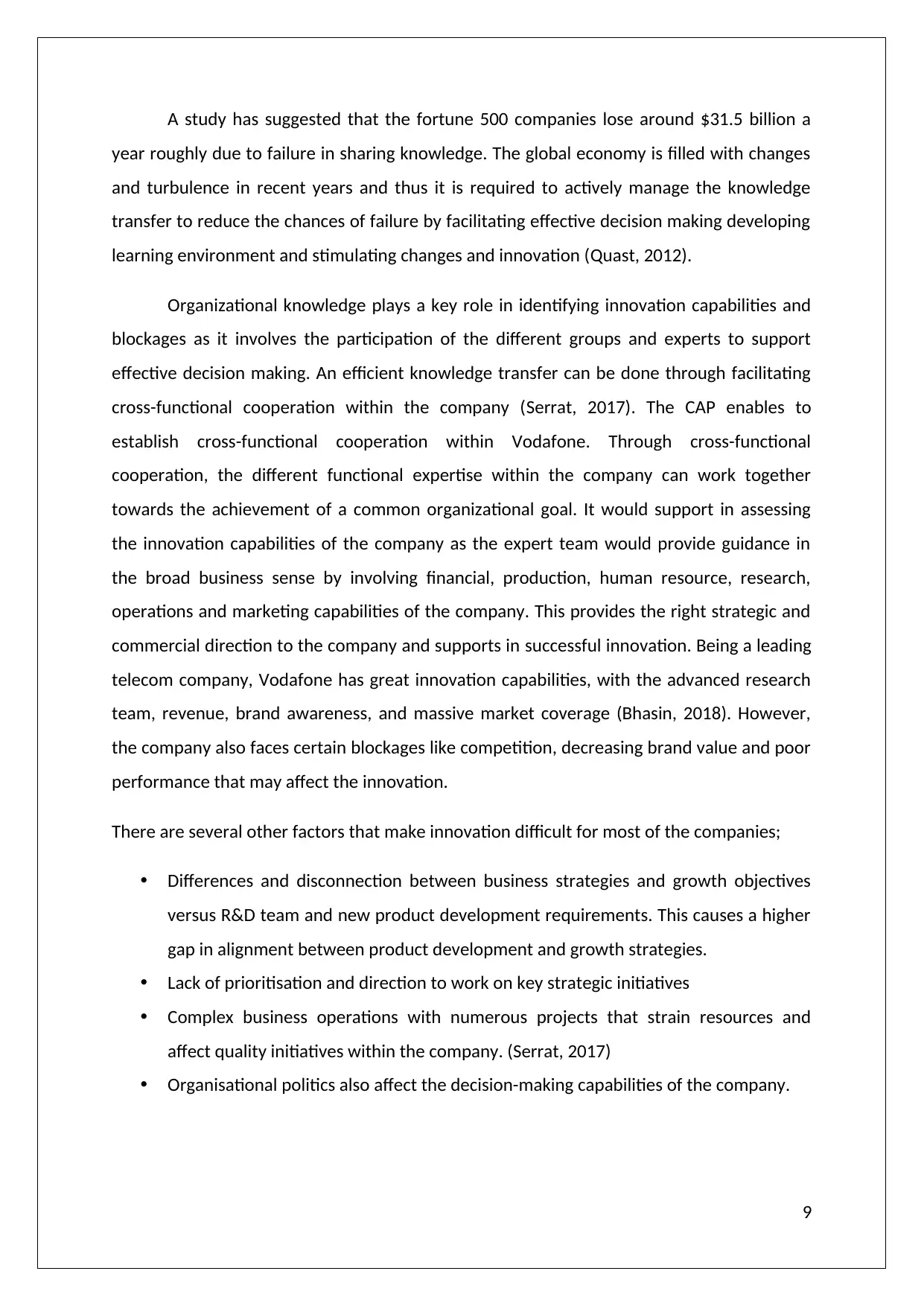
A study has suggested that the fortune 500 companies lose around $31.5 billion a
year roughly due to failure in sharing knowledge. The global economy is filled with changes
and turbulence in recent years and thus it is required to actively manage the knowledge
transfer to reduce the chances of failure by facilitating effective decision making developing
learning environment and stimulating changes and innovation (Quast, 2012).
Organizational knowledge plays a key role in identifying innovation capabilities and
blockages as it involves the participation of the different groups and experts to support
effective decision making. An efficient knowledge transfer can be done through facilitating
cross-functional cooperation within the company (Serrat, 2017). The CAP enables to
establish cross-functional cooperation within Vodafone. Through cross-functional
cooperation, the different functional expertise within the company can work together
towards the achievement of a common organizational goal. It would support in assessing
the innovation capabilities of the company as the expert team would provide guidance in
the broad business sense by involving financial, production, human resource, research,
operations and marketing capabilities of the company. This provides the right strategic and
commercial direction to the company and supports in successful innovation. Being a leading
telecom company, Vodafone has great innovation capabilities, with the advanced research
team, revenue, brand awareness, and massive market coverage (Bhasin, 2018). However,
the company also faces certain blockages like competition, decreasing brand value and poor
performance that may affect the innovation.
There are several other factors that make innovation difficult for most of the companies;
Differences and disconnection between business strategies and growth objectives
versus R&D team and new product development requirements. This causes a higher
gap in alignment between product development and growth strategies.
Lack of prioritisation and direction to work on key strategic initiatives
Complex business operations with numerous projects that strain resources and
affect quality initiatives within the company. (Serrat, 2017)
Organisational politics also affect the decision-making capabilities of the company.
9
year roughly due to failure in sharing knowledge. The global economy is filled with changes
and turbulence in recent years and thus it is required to actively manage the knowledge
transfer to reduce the chances of failure by facilitating effective decision making developing
learning environment and stimulating changes and innovation (Quast, 2012).
Organizational knowledge plays a key role in identifying innovation capabilities and
blockages as it involves the participation of the different groups and experts to support
effective decision making. An efficient knowledge transfer can be done through facilitating
cross-functional cooperation within the company (Serrat, 2017). The CAP enables to
establish cross-functional cooperation within Vodafone. Through cross-functional
cooperation, the different functional expertise within the company can work together
towards the achievement of a common organizational goal. It would support in assessing
the innovation capabilities of the company as the expert team would provide guidance in
the broad business sense by involving financial, production, human resource, research,
operations and marketing capabilities of the company. This provides the right strategic and
commercial direction to the company and supports in successful innovation. Being a leading
telecom company, Vodafone has great innovation capabilities, with the advanced research
team, revenue, brand awareness, and massive market coverage (Bhasin, 2018). However,
the company also faces certain blockages like competition, decreasing brand value and poor
performance that may affect the innovation.
There are several other factors that make innovation difficult for most of the companies;
Differences and disconnection between business strategies and growth objectives
versus R&D team and new product development requirements. This causes a higher
gap in alignment between product development and growth strategies.
Lack of prioritisation and direction to work on key strategic initiatives
Complex business operations with numerous projects that strain resources and
affect quality initiatives within the company. (Serrat, 2017)
Organisational politics also affect the decision-making capabilities of the company.
9
Paraphrase This Document
Need a fresh take? Get an instant paraphrase of this document with our AI Paraphraser
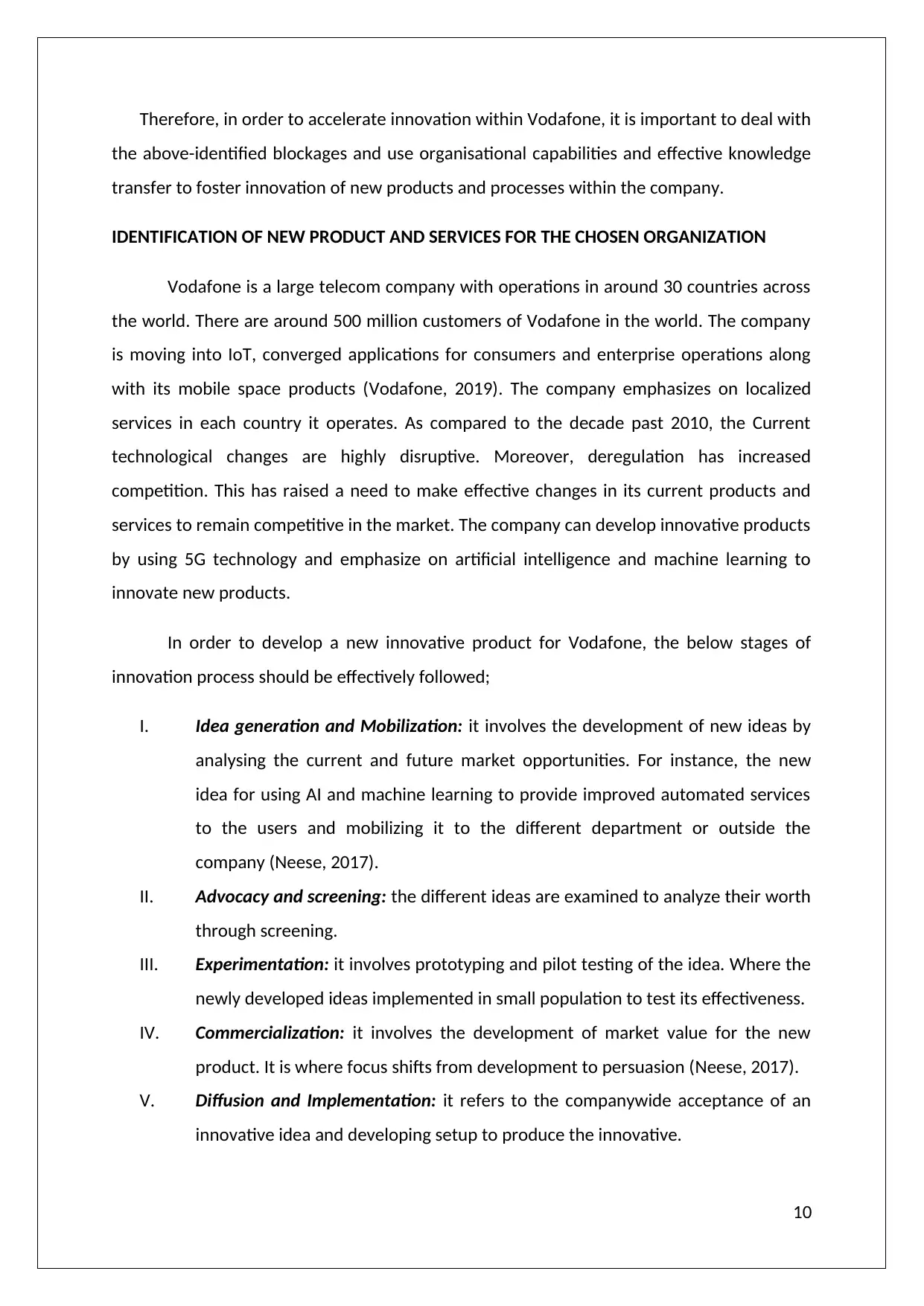
Therefore, in order to accelerate innovation within Vodafone, it is important to deal with
the above-identified blockages and use organisational capabilities and effective knowledge
transfer to foster innovation of new products and processes within the company.
IDENTIFICATION OF NEW PRODUCT AND SERVICES FOR THE CHOSEN ORGANIZATION
Vodafone is a large telecom company with operations in around 30 countries across
the world. There are around 500 million customers of Vodafone in the world. The company
is moving into IoT, converged applications for consumers and enterprise operations along
with its mobile space products (Vodafone, 2019). The company emphasizes on localized
services in each country it operates. As compared to the decade past 2010, the Current
technological changes are highly disruptive. Moreover, deregulation has increased
competition. This has raised a need to make effective changes in its current products and
services to remain competitive in the market. The company can develop innovative products
by using 5G technology and emphasize on artificial intelligence and machine learning to
innovate new products.
In order to develop a new innovative product for Vodafone, the below stages of
innovation process should be effectively followed;
I. Idea generation and Mobilization: it involves the development of new ideas by
analysing the current and future market opportunities. For instance, the new
idea for using AI and machine learning to provide improved automated services
to the users and mobilizing it to the different department or outside the
company (Neese, 2017).
II. Advocacy and screening: the different ideas are examined to analyze their worth
through screening.
III. Experimentation: it involves prototyping and pilot testing of the idea. Where the
newly developed ideas implemented in small population to test its effectiveness.
IV. Commercialization: it involves the development of market value for the new
product. It is where focus shifts from development to persuasion (Neese, 2017).
V. Diffusion and Implementation: it refers to the companywide acceptance of an
innovative idea and developing setup to produce the innovative.
10
the above-identified blockages and use organisational capabilities and effective knowledge
transfer to foster innovation of new products and processes within the company.
IDENTIFICATION OF NEW PRODUCT AND SERVICES FOR THE CHOSEN ORGANIZATION
Vodafone is a large telecom company with operations in around 30 countries across
the world. There are around 500 million customers of Vodafone in the world. The company
is moving into IoT, converged applications for consumers and enterprise operations along
with its mobile space products (Vodafone, 2019). The company emphasizes on localized
services in each country it operates. As compared to the decade past 2010, the Current
technological changes are highly disruptive. Moreover, deregulation has increased
competition. This has raised a need to make effective changes in its current products and
services to remain competitive in the market. The company can develop innovative products
by using 5G technology and emphasize on artificial intelligence and machine learning to
innovate new products.
In order to develop a new innovative product for Vodafone, the below stages of
innovation process should be effectively followed;
I. Idea generation and Mobilization: it involves the development of new ideas by
analysing the current and future market opportunities. For instance, the new
idea for using AI and machine learning to provide improved automated services
to the users and mobilizing it to the different department or outside the
company (Neese, 2017).
II. Advocacy and screening: the different ideas are examined to analyze their worth
through screening.
III. Experimentation: it involves prototyping and pilot testing of the idea. Where the
newly developed ideas implemented in small population to test its effectiveness.
IV. Commercialization: it involves the development of market value for the new
product. It is where focus shifts from development to persuasion (Neese, 2017).
V. Diffusion and Implementation: it refers to the companywide acceptance of an
innovative idea and developing setup to produce the innovative.
10
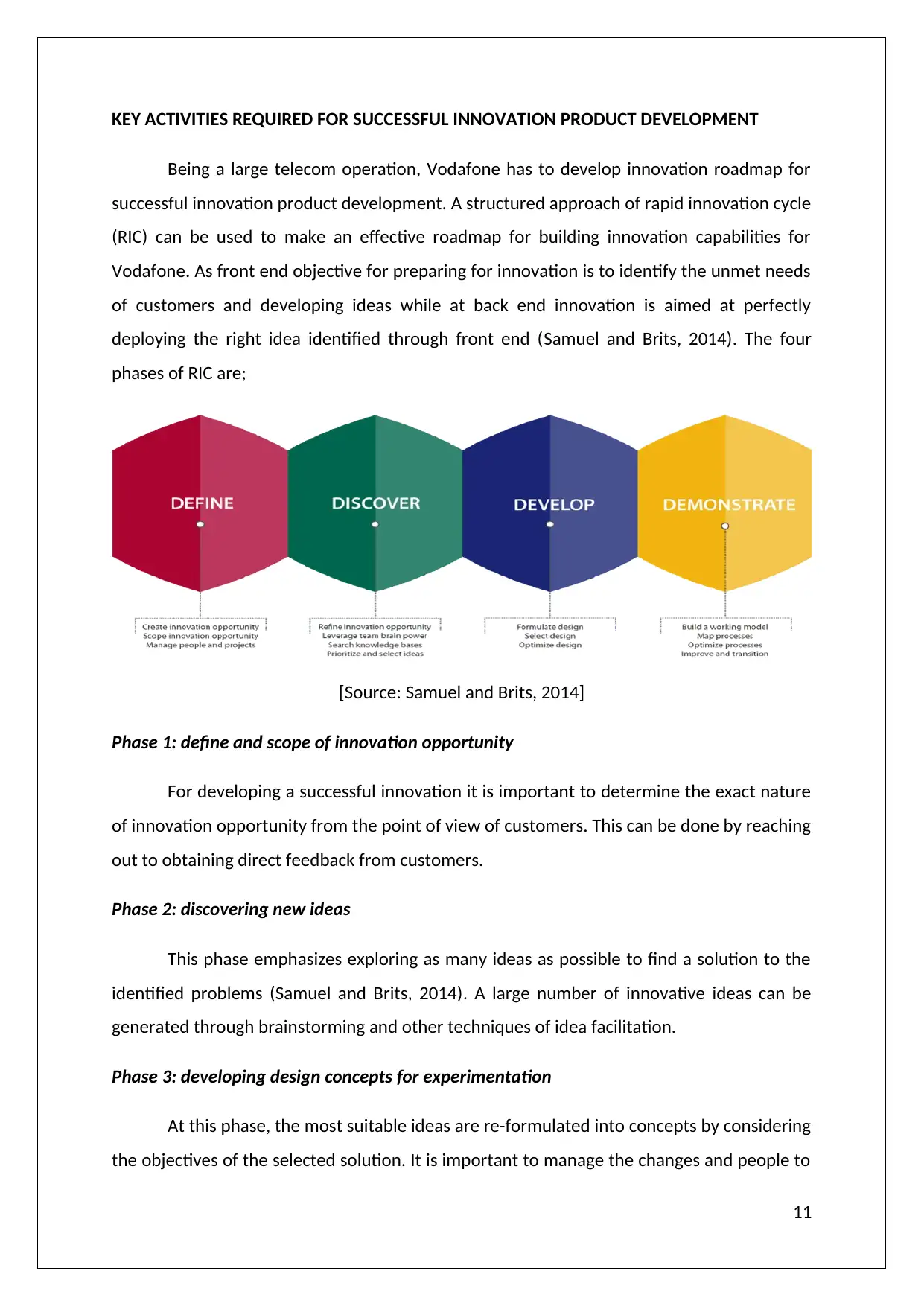
KEY ACTIVITIES REQUIRED FOR SUCCESSFUL INNOVATION PRODUCT DEVELOPMENT
Being a large telecom operation, Vodafone has to develop innovation roadmap for
successful innovation product development. A structured approach of rapid innovation cycle
(RIC) can be used to make an effective roadmap for building innovation capabilities for
Vodafone. As front end objective for preparing for innovation is to identify the unmet needs
of customers and developing ideas while at back end innovation is aimed at perfectly
deploying the right idea identified through front end (Samuel and Brits, 2014). The four
phases of RIC are;
[Source: Samuel and Brits, 2014]
Phase 1: define and scope of innovation opportunity
For developing a successful innovation it is important to determine the exact nature
of innovation opportunity from the point of view of customers. This can be done by reaching
out to obtaining direct feedback from customers.
Phase 2: discovering new ideas
This phase emphasizes exploring as many ideas as possible to find a solution to the
identified problems (Samuel and Brits, 2014). A large number of innovative ideas can be
generated through brainstorming and other techniques of idea facilitation.
Phase 3: developing design concepts for experimentation
At this phase, the most suitable ideas are re-formulated into concepts by considering
the objectives of the selected solution. It is important to manage the changes and people to
11
Being a large telecom operation, Vodafone has to develop innovation roadmap for
successful innovation product development. A structured approach of rapid innovation cycle
(RIC) can be used to make an effective roadmap for building innovation capabilities for
Vodafone. As front end objective for preparing for innovation is to identify the unmet needs
of customers and developing ideas while at back end innovation is aimed at perfectly
deploying the right idea identified through front end (Samuel and Brits, 2014). The four
phases of RIC are;
[Source: Samuel and Brits, 2014]
Phase 1: define and scope of innovation opportunity
For developing a successful innovation it is important to determine the exact nature
of innovation opportunity from the point of view of customers. This can be done by reaching
out to obtaining direct feedback from customers.
Phase 2: discovering new ideas
This phase emphasizes exploring as many ideas as possible to find a solution to the
identified problems (Samuel and Brits, 2014). A large number of innovative ideas can be
generated through brainstorming and other techniques of idea facilitation.
Phase 3: developing design concepts for experimentation
At this phase, the most suitable ideas are re-formulated into concepts by considering
the objectives of the selected solution. It is important to manage the changes and people to
11
⊘ This is a preview!⊘
Do you want full access?
Subscribe today to unlock all pages.

Trusted by 1+ million students worldwide
1 out of 17
Related Documents
Your All-in-One AI-Powered Toolkit for Academic Success.
+13062052269
info@desklib.com
Available 24*7 on WhatsApp / Email
![[object Object]](/_next/static/media/star-bottom.7253800d.svg)
Unlock your academic potential
Copyright © 2020–2025 A2Z Services. All Rights Reserved. Developed and managed by ZUCOL.




